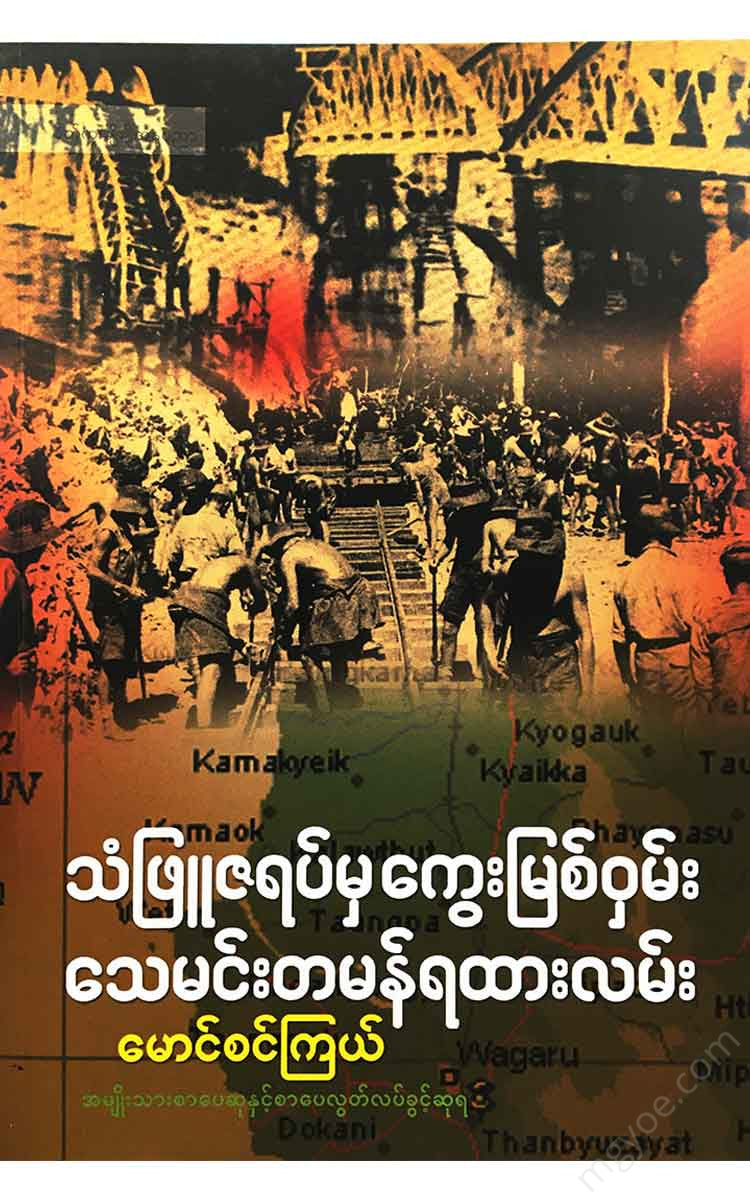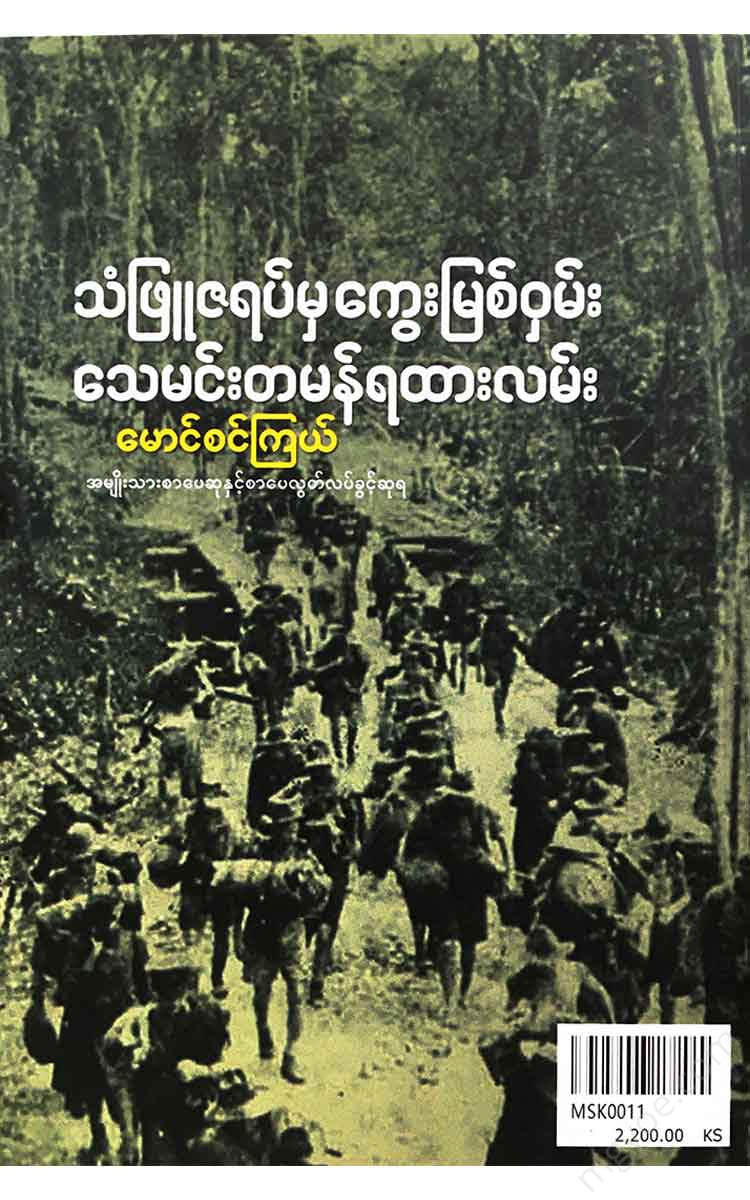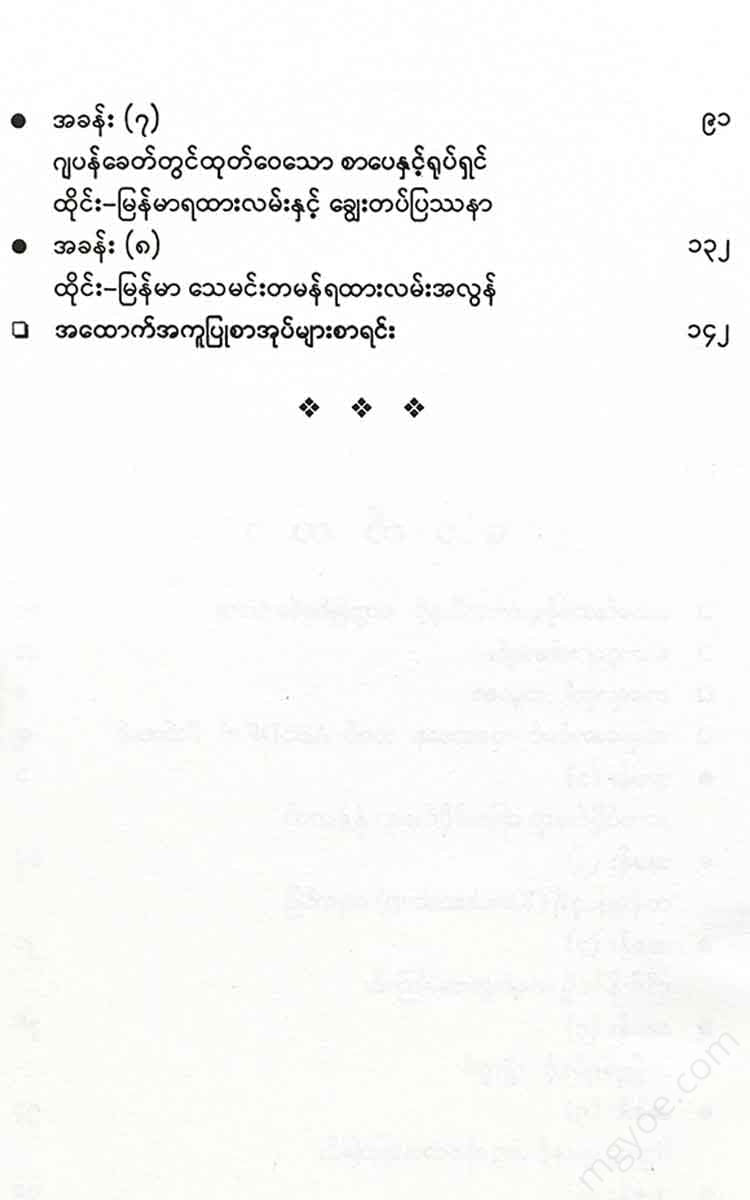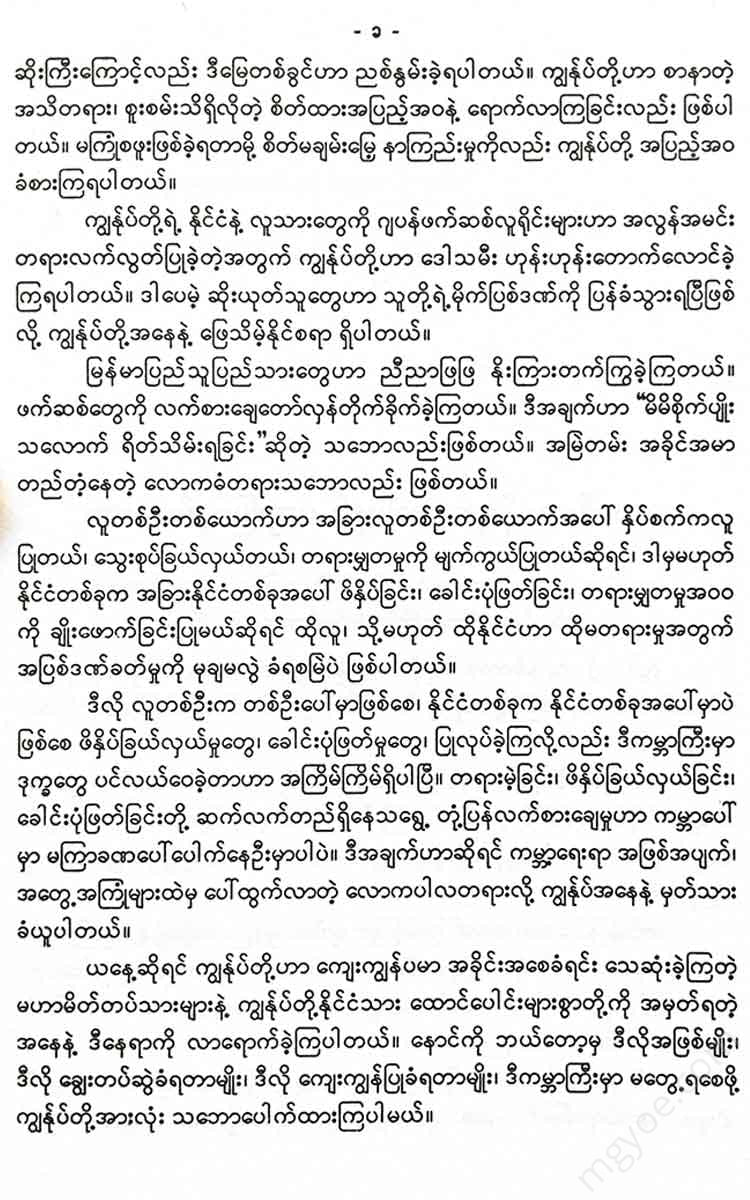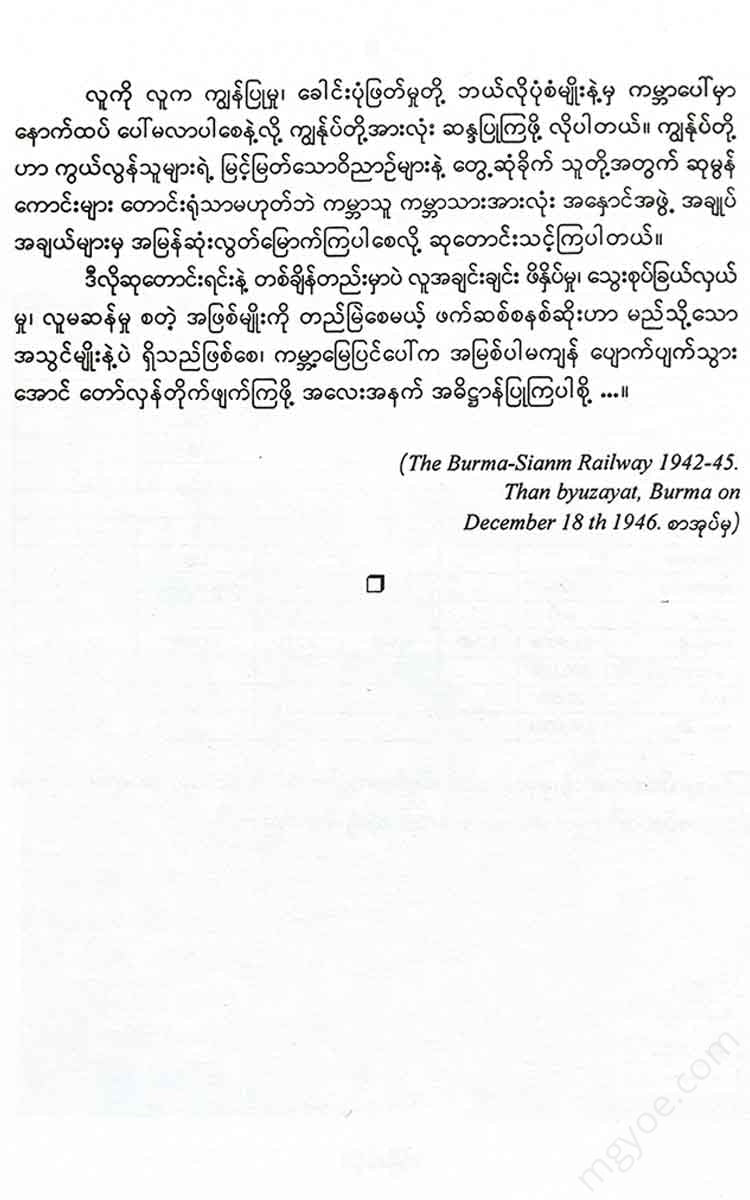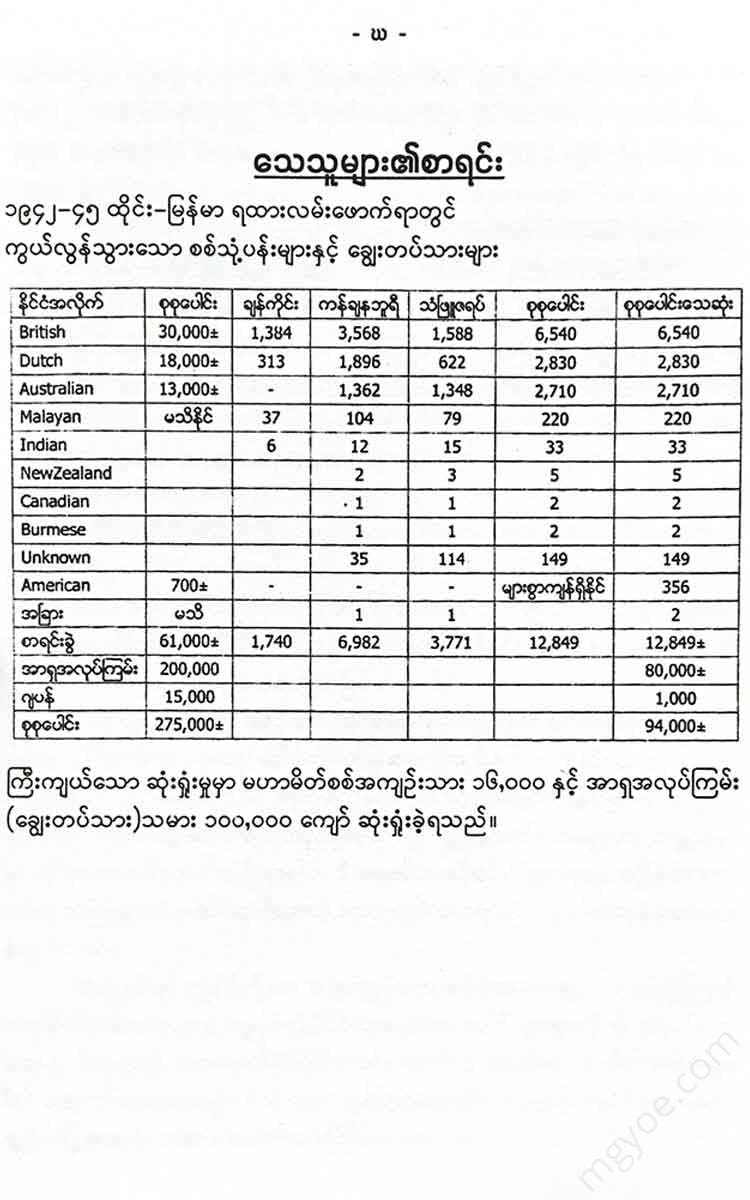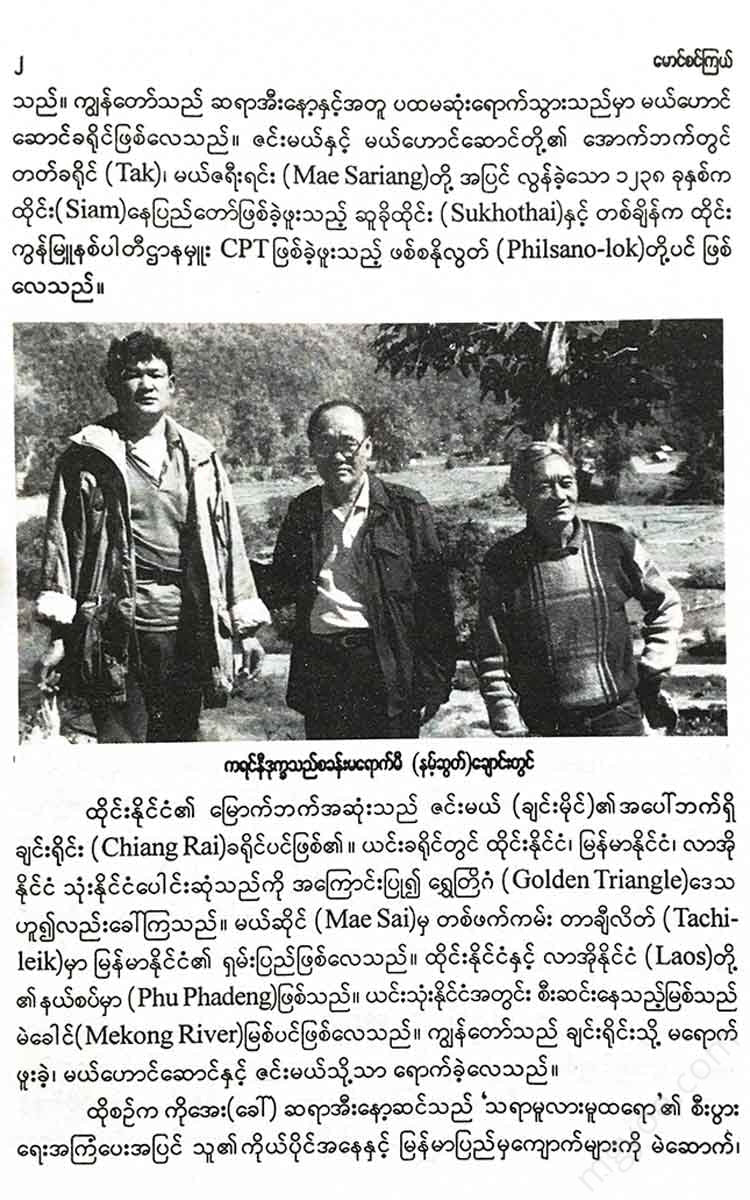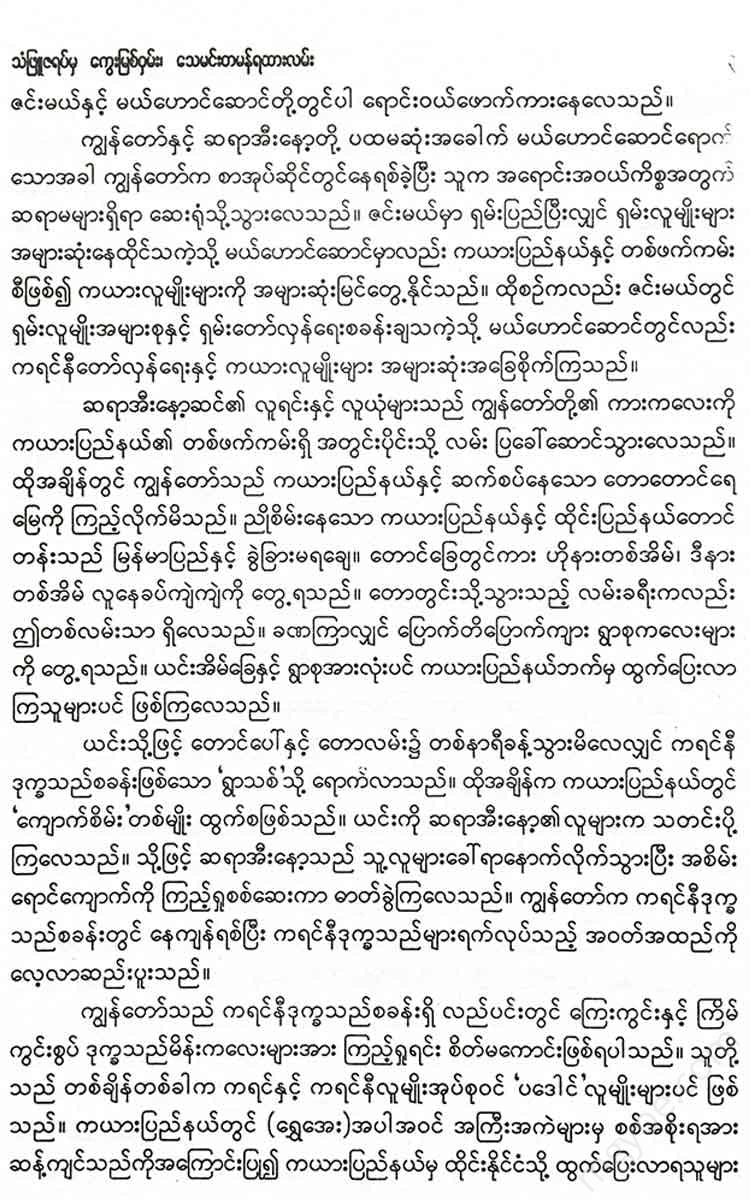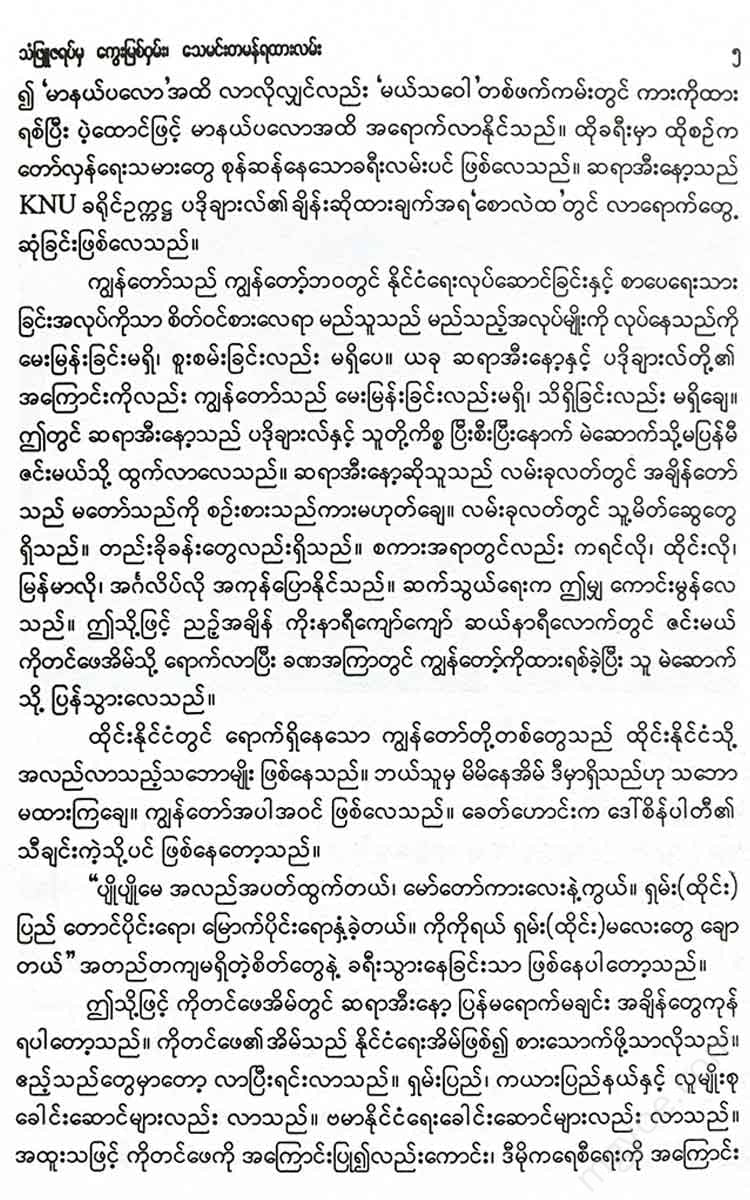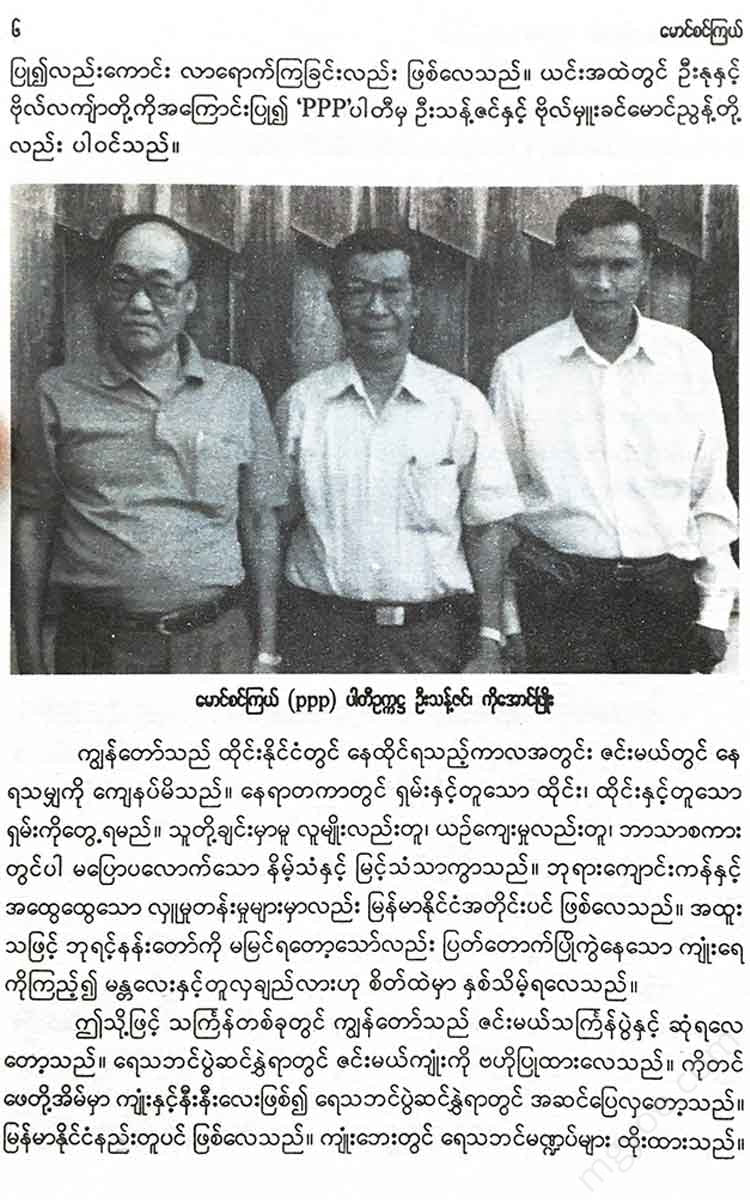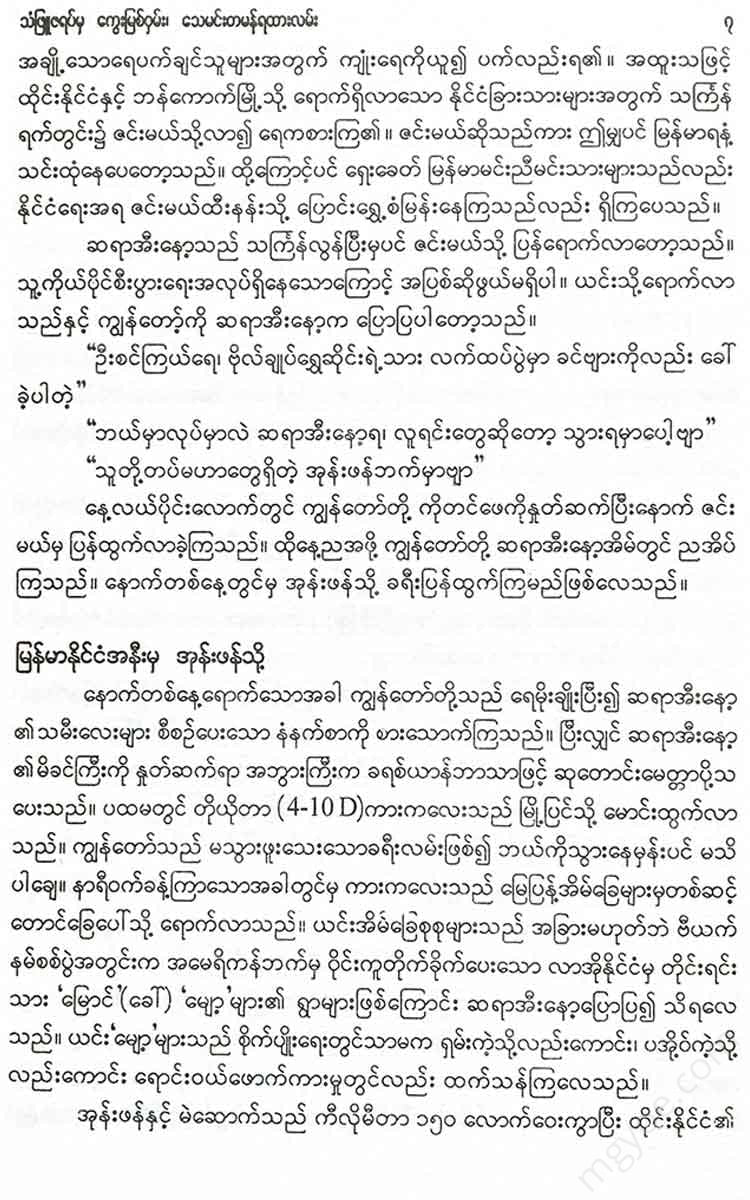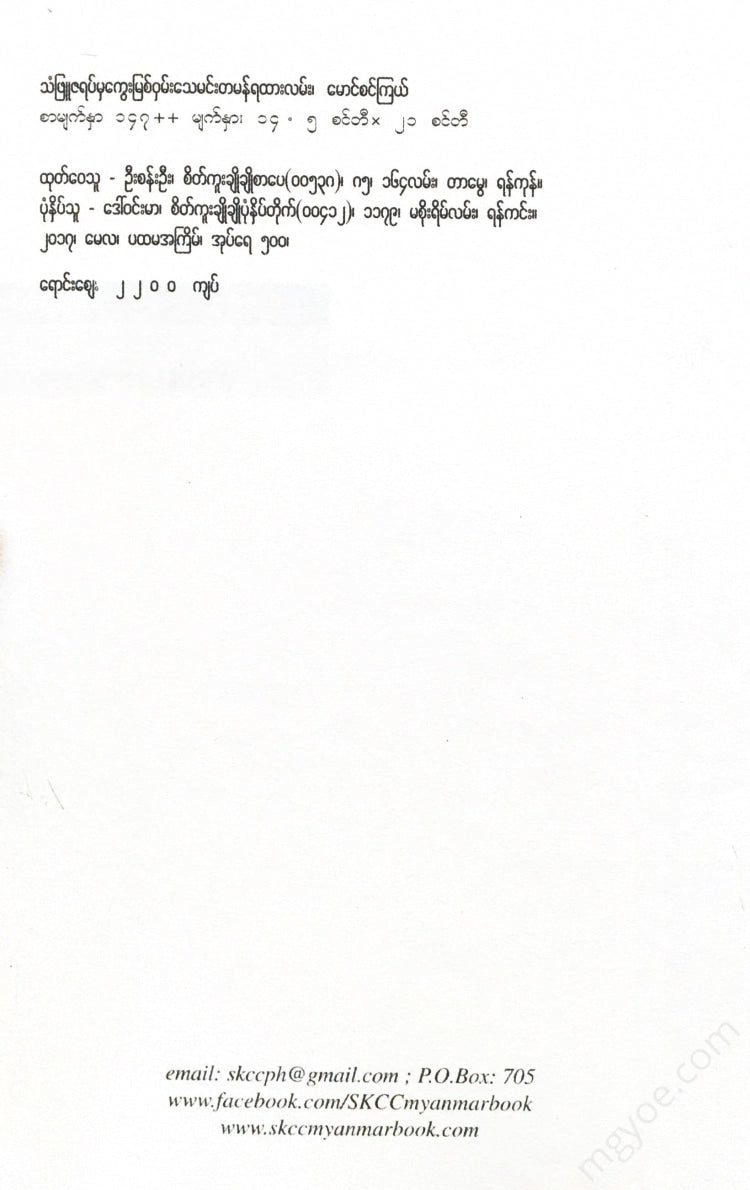စိတ်ကူးချိုချိုစာပေ
Maung Sin Kye - Thanbyuzayat to Kway River Valley Death Railway
Maung Sin Kye - Thanbyuzayat to Kway River Valley Death Railway
Couldn't load pickup availability
Death Railway and Kway River Basin Bridge
Speech by independence leader General Aung San at the opening of Thanbyuzayat War Cemetery in Kyawkham District, December 18, 1946
Four years ago, our country was devastated by war. With that disaster came the evil fascist regime of the Japanese militarists.
The Japanese militarists built the “Thai-Burma Railway” to keep their machinery running. Thousands and thousands of our people were forced into forced labor to build that railway.
Enslaved and tortured in a variety of unspeakable ways , between thirty thousand (30,000) and eighty thousand (80,000 ) forced laborers died of starvation and disease while building the Thai-Burma Railway.
We are now stepping on the ground where the curses and groans of thousands of those who have died have been heard. This land has been tarnished by this tragic event. We have come with a sense of compassion, a sense of curiosity. We have also fully experienced the unspeakable pain and anguish that has been experienced before.
We were filled with rage at the extreme impunity with which the Japanese fascist barbarians had treated our country and people. But we can take solace in the fact that the wicked have now suffered their cruel punishment.
The people of Burma were united and active. They fought back against the fascists. This is also the meaning of "you reap what you sow." It is also a principle of worldly wealth that has always been firmly established.
If one person oppresses another person, exploits them, or turns a blind eye to justice, or if one country oppresses, exploits, or violates all justice, that person or country will inevitably be punished for that injustice.
This world has been plagued by oppression and exploitation, whether by one person or by one country. As long as injustice, oppression, and exploitation continue, retaliation will continue to occur frequently in the world. I consider this to be a worldly law that emerges from world events and experiences.
Today, we come here to remember the thousands of Allied soldiers and our own citizens who died as slaves. We all understand that never again will such a thing be seen in this world, such slavery, such slavery.
We all need to pray that no form of human slavery or exploitation of others will ever again appear on this earth. When we meet the sacred souls of the deceased, we should not only ask for their blessings, but also pray that all the people of the world may be freed from their bondage as soon as possible.
While praying like this, let us also solemnly resolve to fight against the evil fascist system, in whatever form it may take, that perpetuates oppression, blood-sucking, and inhumanity, so that it will be eradicated from the face of the earth...
Chapter (1)
It spread both south and north.
I spent several years in Thailand as a writer and politician. I spent a year and a half in the Mani Loi refugee camp. After that, I went to Australia and then back to Thailand at least ten times, to attend conferences and publish books. During my time in Thailand and after returning from Australia, I spent most of my time traveling. However, my trips during that time were mostly to the north and central parts of Thailand. I had always dreamed of visiting the south.
I went to northern Thailand with Sir Ee Rot (Ee Moe Sin). Sir Ee Noh’s job at that time was to be the economic advisor to General Shwe Seng Thmey (La Mu Traw). In northern and northwestern Thailand were Chiang Mai, Chiang Rai and Mae Hong Son. The first place I went with Sir Ee Moe was Mae Hong Son Province. Below Chiang Mai and Mae Hong Son were Tak Province , Mae Sariang, Sukhothai, which had been the capital of Siam in 1238, and Philsano-lok, which had once been the CPT .
The northernmost point of Thailand is Chiang Rai Province, just above Chiang Mai . It is also known as the Golden Triangle because it is the meeting point of Thailand, Myanmar, and Laos. Across from Mae Sai is Tachi| leik, which is Shan State in Myanmar. The border between Thailand and Laos is Phu Phadeng. The river that flows through these three countries is the Mekong River. I have never been to Chiang Rai, only to Mae Hong Son and Chiang Mai.
At that time, Ko Aye (aka Saya Ee Mo Sin) was “not only the business advisor of Tharamula Muthaw, but also, on his own, was trading and selling stones from Burma in Mae Sot, Zin Mae and Mae Hong Son.”
When Teacher E Naw and I first arrived in Mae Hong Son, I stayed at the bookstore while he went to the hospital where the teachers were to do some business. Just as the Shan people live in Zin Mae, the largest population after Shan State, Mae Hong Son is also on the other side of Kayah State, so you can see the largest number of Kayah people. At that time, just as the Shan people and the Shan resistance camped in Zin Mae, the Karenni resistance and the Kayah people were also based in Mae Hong Son.
Saya E. Mawson’s relatives and friends took our car to the other side of Kayah State. At that time, I looked at the forest and mountains that border Kayah State. The green and brown Kayah State and the Thai State mountains are indistinguishable from Burma. At the foot of the mountains, there are scattered houses here and there. The road to the forest is only this one road. After a while, we saw a small village of guerrillas. All these houses and villages were people who had fled from Kayah State. .
After about an hour of walking through the mountains and forests, we arrived at Ywa Thit, a Karenni refugee camp. At that time, a kind of jade was being extracted in Kayah State. Saya E Naw’s people reported it. So Saya E Naw followed his people and examined the green stone and analyzed it. I stayed in the Karenni refugee camp and studied the clothes that the Karenni refugees made.
I feel sad as I look at the refugee girls in the Karenni refugee camp with their necks covered in copper and cane rings. They were once the “Padaung” people, a group of Karen and Karenni people. They were the ones who fled Kayah State to Thailand because of the opposition of the military government by the leaders in Kayah State (including Shwe Aye). When I published the book “The Manelpalaw Traveler,” I wrote that when the Karen people were officially investigated and officially recognized as a nation to establish a Karen State, the “Padaung” people were so small that they changed from being part of the Karen to being part of the Kayah.
Thus, when I went to Australia and read the famous journal Geographic in a bookstore, I saw a group of African tribes wearing rattan and copper rings around their necks, just like the Padaung people. Human races are not the same as one another in the gradual development of culture. In this, men and women are different. Let's see now. The women not only wear rattan and copper rings around their necks, but also have copper rings and rattan rings on their legs up to their knees.
Northern Thailand
Saya E Naw took a car from Mae Hong Son, a place of pilgrimage in Thailand, to the then market town of “Saw Lai Hta”. From Saw Lai Hta, if you want to go to “Manel Plaw” by rickshaw, you can also go. If you want to go from Mae Sot to “ Manel Plaw”, you can leave the car on the other side of Mae Tha Wol and take a rickshaw to “Manel Plaw”. That journey was the same route that revolutionaries used to travel at that time. Saya E Naw came to meet with KNU District Chairman Pado Charles at Saw Lai Hta as scheduled.
I have been interested in politics and writing in my life, so I have not asked or investigated who is doing what. Now I have not asked or found out about Saya E Mo and Pado Charles. Here Saya E Mo left for Zin Mae after finishing their business with Pado Charles before returning to Mae Sot. Saya E Mo did not think that the time was not right in the middle of the road. He had friends in the middle of the road. There were also guest houses. In terms of language, he could speak Karen, Thai, Burmese, and English. Communication was so good. In this way, at around nine or ten o’clock at night, Zin Mae arrived at Ko Tin Pe’s house, and after a while he left me and returned to Mae Sot.
We, who are in Thailand, feel like we are visiting Thailand. No one feels like home here. Including me. It's like the old Daw Sein Party song.
“ I went on a trip, young lady, and I traveled by car. I traveled to both the southern and northern parts of Shan (Thailand). Oh my, Shan (Thai) girls are so pretty.” I was just traveling with an unstable mind.
Thus, time passed until Saya E Naw returned to Ko Tin Pe’s house. Ko Tin Pe’s house was a political house and food and drink were needed. Visitors came and went. Leaders from Shan State, Kayah State and ethnic groups also came. Burmese political leaders also came. They came especially for Ko Tin Pe and for the cause of democracy. Among them were U Thant Zin and Major Khin Maung Nyunt from the ‘PPP’ party, who came for U Nu and Bo Lek Ya.
During my stay in Thailand, I was satisfied with everything I had in Zin Mae. Everywhere you look, you will find Thais who look like Shans, and Shans who look like Thais. They are the same race, the same culture, and the only difference in language is the low and high tones. The temples and general offerings are also the same as in Myanmar. Especially, although I can no longer see the royal palace, I can look at the broken moat and think, "Is it like Mandalay?"
This is how I came across the Zin Mae Thingyan festival during one of the Thingyan festivals. The Zin Mae moat is the center of the water festival. Ko Tin Pe's house is close to the moat, so it is convenient for holding the water festival. It is the same as in Myanmar. Water festival pavilions are built next to the moat.
Some people who want to splash in the water can also take the water from the moat and splash in it. Especially foreigners who come to Thailand and Bangkok come to Zin Mae during Thingyan and play in the water. Zin Mae is so full of Myanmar flavor. That is why the ancient Burmese kings and princes also moved to the Zin Mae palace for political reasons.
Saya E Naw returned to Zin Mae just after Thingyan. He had his own business, so he could not be blamed. As soon as he arrived, Saya E Naw told me about it.
“ U Sin Yer, I invited you to the wedding of General Shwe Seng’s son.”
" Where will you do it, Teacher E-Mo, I have to go because I'm a family man."
"On the side of Ohmphan where their brigades are."
Around noon, we said goodbye to Ko Tin Pe and left Zin Mae. We stayed at Saya E Mo's house for the night. We would leave for Ohn Phan the next day.
From near Myanmar to Ohnphan
The next day, we took a shower and ate breakfast prepared by Mr. Emo’s daughters. Then, after greeting Mr. Emo’s mother, the old woman said a prayer in Christian terms. First, the Toyota (4-10 D) car drove out of town. I had never been on a road before, so I didn’t know where I was going. After about half an hour, the car drove through a series of mud huts and reached the foot of the mountain. Mr. Emo told me that these huts were none other than the villages of the “Myong” (or “Maw”), an ethnic group from Laos who had fought alongside the Americans during the Vietnam War. These people were not only active in agriculture, but also in trade, like the Shan and the Pa O.
Ohmphan and Mae Sot are about 150 kilometers apart and are part of Thailand.
